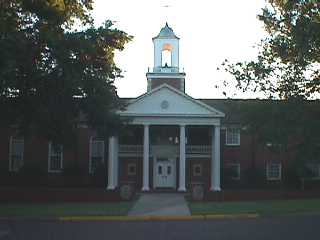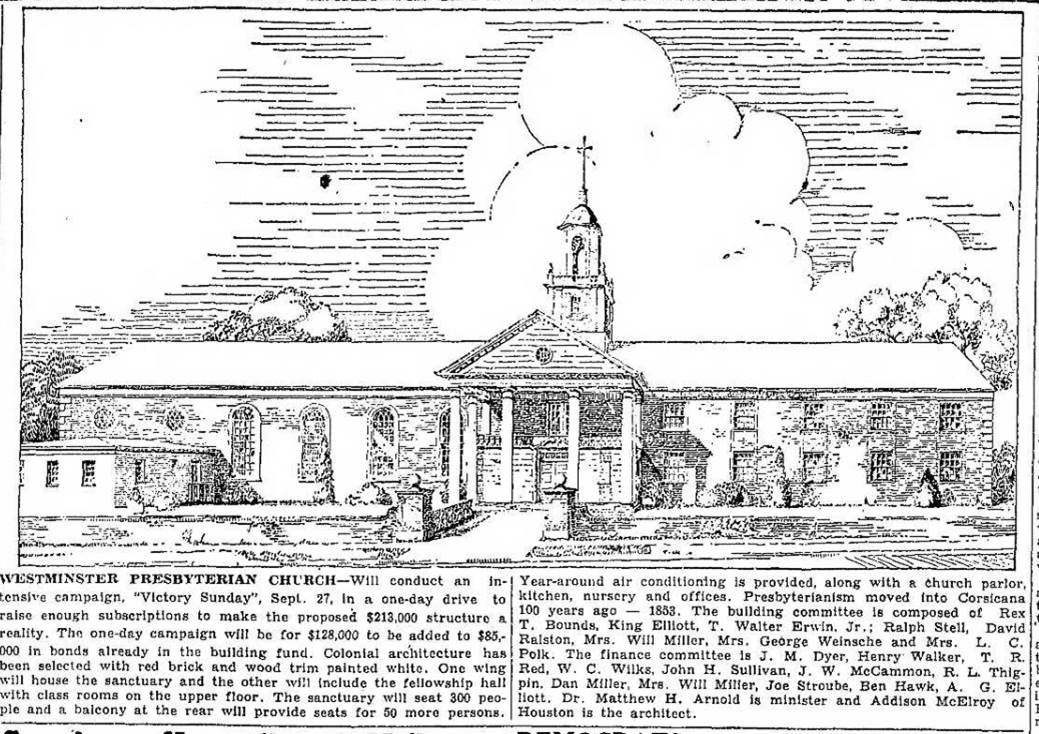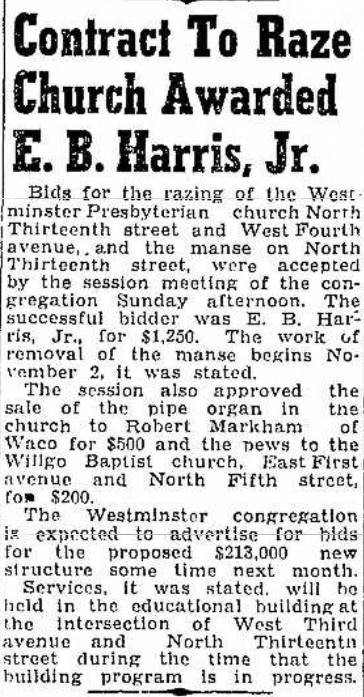A Brief History of the Presbyterian Church
Before we get down to denominations, let us think about the CHURCH, your church, my church, what it means. It is true that it is an organization of Christian people, but the CHURCH must first of all be a place of worship. In the early days of our country, the pioneers first built schools and churches as they moved westward. Sometimes one building served for several purposes and was often referred to as the 'Meeting Place'. We like the term, but it goes much further back than colonial days. God gave the laws and ordinances to Moses at Mount Sinai, and also gave the plan for the order of the Tabernacle. The inner court of which was the Holy of Holies. In the Holy of Holies was the Ark of the Covenant, an oblong chest, overlaid with pure gold. Over the Ark of the Covenant, on the lid, were two cherubim with outstretched wings and beneath the wings was the Mercy Seat, of which God said to Moses, 'There will I meet with thee'. Thus we have a much deeper meaning of the 'Meeting Place'. Scripture records five 'Meeting Places', or places of worship, where God has shown his approval by meeting with and talking to his people; The Alter - Tabernacle - Temple - Synagogue and the Church. First was the ALTER, made of natural stones, about three feet high and used for burnt offerings, a form of worship. The Altar was a place of worship from the time of the flood to the giving of the law at Mount Sinai, a period of some eight hundred and fifty years, (850) Second, the Tabernacle a portable structure, leading in the line of march in the wilderness, taking its place in the center of the tribes when they came into camp. The Tabernacle continued as a place of worship until the entry into Canaan, and came to rest at Shiloh, a period of five (500) hundred years. Third, the Temple. King David, the second king of Israel, after building for himself a palace, became concerned that the Ark of the Covenant remained in curtains, or, (tent or tabernacle). He began plans to build a permanent place for the Ark of the Lord, namely the TEMPLE. However, since David had been a man of war, he was told by the prophet Nathan that he would not be allowed to build the temple but that his son Solomon would build it. So the Temple built by Solomon was a place of worship until the time of the first captivity, some four hundred (400) years. Later it was rebuilt and stood until the time of Christ, as it is recorded that he entered the Temple and the Synagogue as was his custom. Thus the Temple and the Synagogue were places of worship at the time of Christ. Too, we must remember that we have with us today as places of worship by our Jewish friends, the Temple and the Synagogue. On 15th Street we have Temple Beth-El and on West Park Avenue the Synagogue of the congregation of Agudas-Achim. Fifth we have the Church which became a place of worship after the day of Pentecost. After the reformation, under Martin Luther, we began to have denominations, one of which was PRESBYTERIAN. The foundation principles of this faith being laid down by John Calvin in northern Europe, later by John Knox in Scotland. The early Presbyterians to this country came principally from Scotland and among its leaders were Francis Makemie, John Witherspoon and others. The Presbyterian denomination, like most other church groups, began to have doctrinal differences, or, different interpretations on the doctrines until, as shown by a census in 1949, there were nine (9) branches of the Presbyterian branches, however, subscribe to the Westminster Confession of Faith as laid down in July 1643. Of these nine branches of Presbyterianism in the United States, we have had five (5) in Corsicana and Navarro County between the period of 1895 and 1935. The first organized congregation of Presbyterians in the County was the Cumberland. This organization in 1853 began worship in a log building, shared with the Methodist, at North Church Street (now 15th Street) and Second Avenue. Later they built their first church in the block north of the Courthouse, and perhaps a second building at or near that point. In 1893, the Cumberland Presbyterians built, what to that time was the finest church in Corsicana, at Third Avenue and North Thirteenth Street. From a membership roll at that time we find names of many of Corsicana's best citizens. The Cumberland Church had related groups in the County at Dawson, Blooming Grove, and in the northeastern part of the County. The Churches at Corsicana and Dawson are active today. It was the Cumberland organization that first made the contribution of the name of 'Church Street' to what is now Fifteenth Street. This street might well be called Church Street today as it has nine churches on its border from Third Avenue to Eighteenth Avenue. The second organization group of Presbyterians was of the U.S. branch and known locally as the Corsicana Presbyterians. This congregation began it 1868, was incorporated in 1872 under the above name until about 1895 when it changed its name to First Presbyterian. This first building used by these people was a wooden structure near where the Navarro Hotel now stands. A second building was erected on the corner of Fourth Avenue and Thirteenth Street. This building did not last more than a few years, being of faulty construction and of second-hand materials. In 1903 a brick veneer building was erected at the same location and served as a place of worship for this congregation until 1954. This branch of Presbyterians, U. S., also had related churches in the County at Eureka, Frost, and Midway, and were served by Rev. J. A. Creighton, as County Evangelist, from October 1893 to April 1896. The third organized group of Presbyterians, in Corsicana, was established in 1895 as the Associate Reformed Presbyterians. Charter members, for the most part, came from the Eureka A. R. P. Church originally. This group first worshipped at the old City Hall. In 1899 a brick veneer church was erected at the corner of Fourth Avenue and Fifteenth Street. It will be noted that at this time there were the Cumberland and First Presbyterians in Corsicana and out of this fact came a thing of interest. At the dedication of the Associate Reformed Church in 1899, a local attorney who had done some legal work for the group was asked to make some remarks. He stated that he had known of the Cumberland Presbyterians and of the Southern Presbyterians, but that he had not known much of the Associate Reformed Presbyterians, but that he was 'glad they had reformed'. As stated above, many of the character members of the Corsicana A. R. P. Church had lived at Eureka, where an Associate Reformed Presbyterian Church had been organized in 1876 by the Rev. William Little Patterson. Immediately after the Civil War, Rev. T. J. Bonner had gone to the community of Fairfield - Stewards Mill and held services for members of the Associate Reformed Church in that locality. It was to this point that Rev. W. L. Patterson came from Georgia, under the direction of the church headquarters. Rev Patterson served the church at Eureka, known then as the Richland congregation, as pastor for more than twenty years. He served that community as a man of God for more than fifty years. He was human, but with a touch of the Divine, for he too 'Went about doing good'. The original church built in 1876, part of the material being brought from Houston, was located some two miles below the business point of Eureka. This building was torn down in 1924 and the location moved to the business center of Eureka and was dedicated as "Patterson Memorial Presbyterian Church, U. S.". The fourth Presbyterian branch, the U. S. A. (Northern) came into Corsicana after the union of the Cumberland and U. S. A. bodies through their General Assemblies in 1906. This action was not unanimous in the Corsicana group and a minority continued as Cumberland and have a church at 1822 West Second Avenue at this time. The majority of the Cumberland group continued to occupy the building at Third Avenue Presbyterian, U. S. A. Today this group has a related congregation in Kerens. In 1908, the Associate Reformed Church, through its General Assembly, exchanged certain properties in Texas with the United Presbyterians of Pittsburgh, Pa. and the A. R. P. Churches in Texas became United Presbyterians. The A. R. P. United group in 1935, under congregation, Presbytery and Synod action, joined with the First Presbyterian Church of Corsicana, thus losing its identity as A. R. P. - United Presbyterians. It will be noted that we now have the original congregations of five Presbyterian branches located between Third Avenue and Fourth Avenue, on Thirteenth Street; the five groups represented in the two churches; Third Avenue Presbyterian, U. S. A. and the First Presbyterian U. S. In 1949 an official discussion developed between members of the two groups, U. S. A. and U. S. to unite, or federate. This matter was presented to the respective Presbyteries, Central Texas U. S. and Waco Presbytery U. S. A. Permission was granted, as there was at that time a plan to unite the two bodies nationally and the local congregations felt that they were only anticipating what would take place nationally. The federated churches in 1949 became the Westminster Presbyterian Church. The minister serving the Third Avenue group at that time of the federation was Rev. Matthew H. Arnold, D. D. , who continued as the pastor until 1956. One of the articles of Federation was that all buildings on the half block of ground between Third and Fourth Avenues on Thirteenth Street, were to be cleared from the location and a modern building be erected at that site. Construction on the first unit of the master plan was begun in 1954. By the time the first unit had been completed, it was found necessary that more room be provided, so the second and final plan was begun and completed in 1956. Today we have a modern church plant with a full time program, a membership of six hundred and the property representing a value of $300,000.00 entirely free of debt. The present minister serving the WestminsterPresbyterian Church is Rev. Eugene E. Wood. Presbyterians have not been able to claim a large membership, in comparison with some of the other denominations, but we believe it can be shown that in communities where Presbyterian congregations have been established, their impace on the spiritual and cultural life of the community has been out of proportion to their numbers. Of the past presidents of United States, six have been Presbyterian, with a seventh, Lincoln, while not formally a member attended the Presbyterian church. It is told of William J. Bryan, on an occasion where a group of friends were showing him a special honor, that he stated that he felt that the highest honor that had ever been showed him was when he had been made a Ruling Elder in the Presbyterian Church. It is the privilege of everyone; it is the responsibility of everyone, to contribute something, in his day, to the ongoing of the spiritual kingdom. And, if it is true that each generation builds a better church, as we have shown to have been true in the 107 years of Presbyterian history in Corsicana, then this is also one way we can have a part in building the Kingdom. It is our feeling that our churches, to the extent of the congregation's financial ability, should be fine and beautiful. Beautiful from the outside so that they bespeak to all that pass by that this group of people love their place of worship. Churches should be beautiful and rich in appointment in the inside, taking the Tabernacle and the Temple as examples, so that those who enter there may feel the sacred silence that leads to an attitude of worship. When we look upon a beautiful church we feel that it must have been an experience like this that led Ruskin to pin these lines: "Therefore, when we build, let us think that we build forever. Let it not be for present delight, nor for present use alone, let it be such work as our descendants will thank us for, and let us think as we lay stone on stone, that a day is to come when these stones will be held sacred, because our hands have touched them, and men will say as they look upon the labor and wrought substance of them, See this our Fathers did for us. -- Ruskin.
The Corsicana Daily Sun
- Wed., Aug 1, 1956
The Corsicana Daily Sun
- Tues., Oct. 27, 1953
Notes: |
 We have been asked to give some of the history of the Presbyterian Church in Corsicana and Navarro County. This history covers a period of one hundred seven years, from 1853 to 1960; a part of four generations.
We have been asked to give some of the history of the Presbyterian Church in Corsicana and Navarro County. This history covers a period of one hundred seven years, from 1853 to 1960; a part of four generations.
